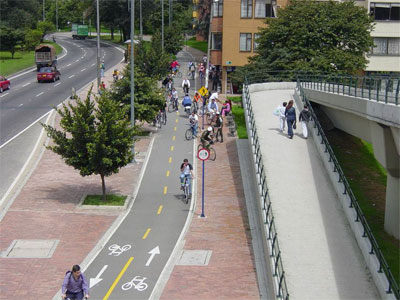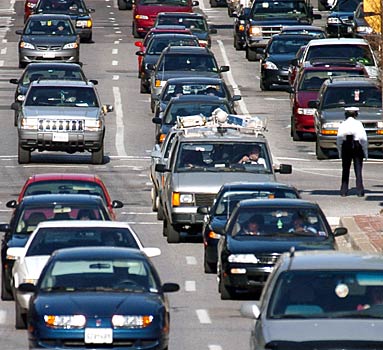An automobile centric planning paradigm
DC1974 sends us notice of this story, "In Portland, Cultivating a Culture of Two Wheels," from the New York Times. And he writes:
Look at all those bike racks! And bike racks in the streets where parking spaces would be! How fantastic.
An interesting thing about this story, or some of the stories from Europe about Velib or bicycling policy in the Netherlands ("The Dutch government takes a stand -- against cars, for bikes" and "No Vélib’ in Amsterdam"), or what Enrique Penalosa did in Bogota, or the fact that the "Gentle Mobility" transportation policy in Graz, Austria means (among other things) that the city-wide speed limit is about 20 mph, is that these counter-examples demonstrate how car-centric North American thinking is about transportation planning.

Bogota
E.g., my entry yesterday about Whole Foods was more of a rhetorical question, meaning if Whole Foods can offer car validation it can support transit similarly. The Economist blog picked up that entry and made the point, correctly, in "Who says supermarkets are dumb?" that Whole Foods offers parking validation to compete for customers who have other choices and who drive, while transit users and walkers likely have more limited choices and therefore don't require incentives in order to be induced to patronize the store.
Of course they are right.
But I should have been more direct about what I meant, which is that most businesses and institutions should be required to produce transportation demand management plans, and this includes supermarkets, to maximize mobility and optimum infrastructure utilization. In such plans, car users shouldn't be privileged, despite the economic reality pointed out by The Economist, because we need to promote better mobility choices overall. TDM is about equalizing the mobility playing field, rather than maintaining privileges.
This is about optimizing the economics of the transportation system, rather than optimizing the economics of the individual. Transportation is an area where the sum of individual choices is not optimized through the unseen hand. The photo below shows the typical product of the sum of individualized mobility decisions.

Traffic backs up on Lombard Street, Baltimore. Baltimore Sun photo.
Not only should Whole Foods (and other supermarkets) support transit and walking use, they should provide delivery services... Better that one vehicle make 15 stops rather than 15 vehicles drive to the store.
Labels: bicycling, car culture, mobiliy, transit, transportation planning



0 Comments:
Post a Comment
<< Home